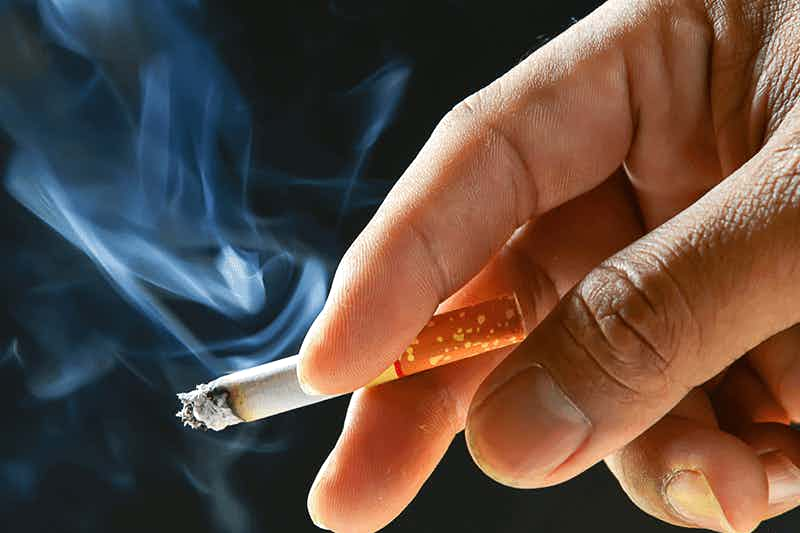When vapers ask how much nicotine is in a cigarette, it’s often because they’re trying to calculate what nicotine strength they want in e-liquid. The idea is to mimic the hit they get from cigarettes, and get the same nicotine experience from vaping that they do from smoking.
But knowing how many milligrams of nicotine are in one cigarette won’t necessarily translate to vaping. That’s because the method of delivery is much different, and even an equivalent amount of nicotine won’t provide the same kick when delivered in a vape versus in a cigarette.
Nicotine is a complex topic. We're a vaping publication, and most of our nicotine articles are focused on vaping. But because most vapers were once smokers, and because lots of smokers are looking for low-risk alternatives to cigarettes, we want to explore all aspects of nicotine usage. Also, this is a pretty interesting topic, and if the FDA manages to reduce nicotine in cigarettes below addictive levels, it will become even more interesting!
How much nicotine is in a cigarette?

Exactly how much nicotine is in one cigarette? It’s a simple question, right?
Well, no. There is between 0.65 and 1 gram of tobacco in an average unlit cigarette, which includes somewhere between 7.5 and 13.4 milligrams of nicotine, according to testing done at Penn State University. Newport cigarettes had the most nicotine of any American brand tested, at 13.4 mg per cigarette.
A Marlboro red contains 10.9 mg of nicotine, and the median of all the brands tested was 10.2 mg per cigarette. A separate study by Centers for Disease Control and Prevention (CDC) scientists shows that Newport and Marlboro brands contain about the same amount of nicotine (19.4 and 20.3 mg) per gram of tobacco. The mean nicotine content for all brands tested by the CDC was 19.2 mg per gram of tobacco.
That certainly debunks the claim that one JUUL pod contains “as much nicotine as a pack of cigarettes.” A JUUL pod contains 41 mg of nicotine (0.7 mL X 59 mg/mL), but an average pack of cigarettes contains 204 mg of nicotine (20 cigarettes X 10.2 mg)—and some brands contain considerably more.
But the question shouldn’t be how many milligrams of nicotine are in a cigarette. Rather, the issue is how much nicotine from a cigarette is absorbed by the smoker. It’s complicated.
According to Professor Bernd Mayer of the Department of Pharmacology and Toxicology at Karl-Franzens University Graz (Austria), “Smoking a cigarette results in uptake of approximately 2 mg of nicotine and gives rise to mean arterial plasma concentrations of about 0.03 mg/L (30 ng/mL).” Mayer is a known expert on nicotine, but other researchers have slightly different answers. UCLA professor Arthur Brody says typical “light” cigarettes yield 0.6-1.0 mg, and regular smokes 1.2-1.4 mg per cigarette.
So cigarettes deliver a lot less nicotine to the smoker than they actually contain. The difference may seem huge, but in reality it may not matter. That’s because smokers (and vapers) in large part control their uptake of nicotine, and because other factors account for a big part of a cigarette’s powerful nicotine delivery.
Nicotine is nicotine, right?
When we use nicotine, we decide ourselves how much we take in—by smoking more or less, faster or slower, and with greater or lesser frequency. That’s called self-titration, and all nicotine consumers do it.
You know what it feels like to have too much nicotine, right? Whether you’re getting the drug from cigarettes or a vape, the effects are the same:
But because our bodies know when we’ve had enough, we stop or slow down. For experienced nicotine users, the process is almost subconscious. Self-titration is our brain telling us when our body needs more or less. And those warning signs are what prevent nicotine overdoses. Nobody O.D.’s on cigarettes or vapes. You’d have to keep inhaling while vomiting and dealing with a splitting headache!
So nic users keep themselves in check with self-titration. But getting nicotine from a cigarette is a little more complicated. Between tobacco itself and tobacco company tactics, cigarettes are built to deliver a supercharged dose of nicotine to the brain.

Aside from nicotine, cigarettes contain other chemicals that power the nicotine delivery of the smoke. Monoamine oxidase inhibitors (MAOI’s) combine with nicotine to produce a reinforcing effect in the brain that makes users want nicotine more often.
And tobacco companies discovered long ago that adding ammonia to cigarette tobacco created a form of nicotine that was more desirable, and more addictive to the user. By changing the chemistry of the nicotine that the smoker absorbs, ammonia supercharges the nicotine as it hits the brain.
Those are all reasons why we can’t simply compare the nicotine content of a cigarette to an equivalent amount of nic in e-liquid or a nicotine patch. Vapes don’t have ammonia or MAOI’s. That’s one reason why some scientists say nicotine in e-cigarettes and nicotine replacement therapy (NRT) products is probably not as addictive as it is in cigarettes.
How much nicotine is in a cigar?
The CDC research team that measured the per-gram nicotine content of dozens of cigarette brands also investigated cigars. While none of the cigar types the CDC tested were close in average nicotine content to cigarettes, large cigars (premium, sometimes hand-rolled) were the closest. Here are the cigar types with the mean nicotine concentrations for each, compared to cigarettes:
Even cigars that contain as much or nearly as much nicotine as cigarettes probably don't deliver it as effectively to the smoker. Cigar smokers don’t typically inhale deeply (or at all), and cigars aren't treated with ammonia to enhance the addictive power. That’s not to say that cigars can’t be addictive, but they don't seem to provide the addictive blast of a cigarette.
What if cigarettes had NO nicotine?

In July 2017, then-FDA commissioner Scott Gottlieb announced that the agency was beginning research on a plan to reduce the nicotine in cigarettes to non-addictive levels.
The theory is that by eliminating cigarettes’ addictive potential while allowing high-nicotine alternatives like e-cigarettes and NRT products to remain on the market, many smokers would migrate to the low-risk alternatives. Proponents of the plan say that youth experimenters would never get addicted to cigarettes at all.
It’s not a new idea. Tobacco control scientists have discussed lowering the nicotine in cigarettes since at least 1994, and recently clinical trials have been conducted on a so-called very low nicotine cigarettes (VLNC)—which are sometimes called reduced-nicotine cigarettes.
"What would prevent a massive black market of nicotine-filled cigarettes?"
The VLNC plan faces many challenges. First, it will take a long time—and that means the plan will have to be carried out by multiple administrations and FDA regulators. And to make it possible, the FDA would have to show that it could enforce the rule. What would prevent a massive black market of nicotine-filled cigarettes?
Additionally, serious large-scale trials would have to show real potential for VLNCs to succeed. Finally, Congress could buckle to cigarette industry pressure and amend the Family Smoking Prevention and Tobacco Control Act to eliminate the FDA’s authority to alter the nicotine content at all.
But if the FDA manages to pull it off—if the agency is able to eliminate 90 percent or more of the nicotine from cigarettes—it would be one of the most significant political and public health events in decades.

Jim McDonald
Vaping for: 13 years
Favorite products:
Favorite flavors: RY4-style tobaccos, fruits
Expertise in: Political and legal challenges, tobacco control haters, moral panics
Jim McDonald
Smokers created vaping for themselves without help from the tobacco industry or anti-tobacco crusaders, and I believe vapers and the vaping industry have the right to continue innovating to give everyone who wants to use nicotine access to safe and attractive non-combustible options. My goal is to provide clear, honest information about vaping and the challenges nicotine consumers face from lawmakers, regulators, and brokers of disinformation. You can find me on Twitter @whycherrywhy


